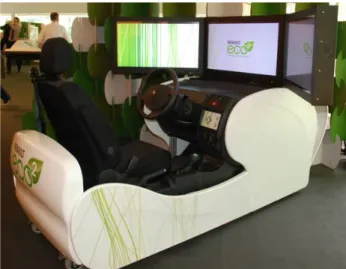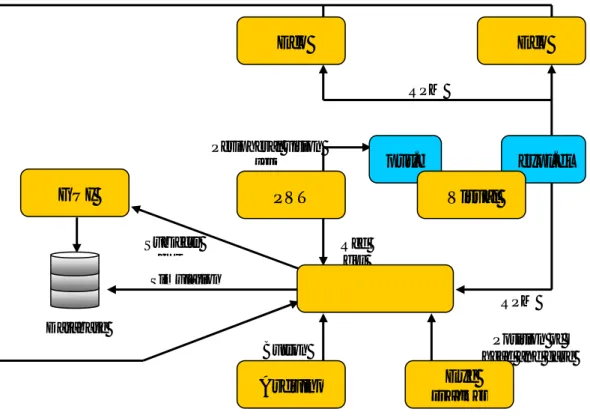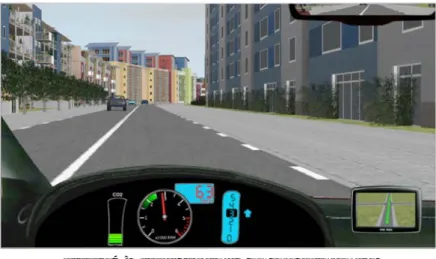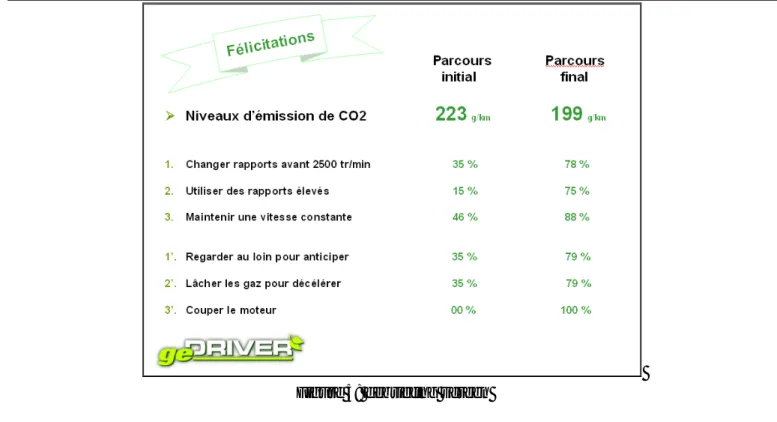is an open access repository that collects the work of Arts et Métiers Institute of Technology researchers and makes it freely available over the web where possible.
This is an author-deposited version published in: https://sam.ensam.eu
Handle ID: .http://hdl.handle.net/10985/6876
To cite this version :
Sabrina BELOUFA, Fabrice CAUCHARD, Joël VEDRENNE, Jean-Michel BOUCHEIX, Andras KEMENY, Frédéric MERIENNE, Benjamin VAILLEAU - Enhanced game mode for Eco-driving simulator - In: Driving Simulation Conference 2012, France, 2012-09-06 - Driving Simulation Conference 2012 - 2012
Driving Simulation Conference 2012 Paris, France, September 6-7, 2012
Enhanced game mode for Eco-driving simulator
Beloufa Sabrina1,2, 3, Cauchard Fabrice3, Vailleau Benjamin1, Vedrenne Joël2, Boucheix Jean-Michel3, , Kemeny Andras1, 2, Mérienne Frédéric2
1
RENAULT, Technical Center for Simulation – TCRAVA 013 , 1 avenue du Golf 78288 GUYANCOURT E-mail: sabrina.beloufa@renault.com, benjamin.vailleau@renault.com, andras.kemeny@renault.com
2
Arts & Métiers Paristech – Institut image ENSAM – 2 rue Thomas Dumorey 71100 Chalon sur Saône E-mail : frederic.merienne@ensam.eu, joel.vedrenne@ensam.eu
3
LEAD, Université de Bourgogne - CNRS UMR 5022 - Université de Bourgogne Pôle AAFE - Esplanade Erasme - BP 26513 - 21065 Dijon CEDEX
E-mail : Jean-Michel.Boucheix@u-bourgogne.fr, Fabrice.cauchard@u-bourgogne.fr
Abstract
The use of driving simulators is part of RENAULT’s approach for eco-driving development. The geDRIVER project objectives were to: develop ECO mode for all, taking into account eco-driving criteria; develop a training business offer and develop specific assistance HMI (Human Machine Interface).
In terms of driving simulation, this induced a need to develop a wide range deployment training tools integrating multisensorial feedback, enhanced gameplay for scenario design, and driving analysis tool into ECO² simulator.
Several experiments were carried out, in order to evaluate validity of simulation for an eco-driving training purpose.
Results show that visual indicators is the most appropriate and that the eco-driving rule “gear up at 2500 rpm” is the most efficient. At last, the simulator appears to be an efficient tool, to understand and integrate eco-driving rules, and to improve economies in terms of CO2 emissions.
Key words: Eco-driving, Driving simulation, Serious game, Learning, Human machine interface.
I. Introduction
Analysis of driver behavior has been the purpose of many studies for several years. This is linked with expansion of driving assistance systems in modern vehicles, as well as development of new systems and solutions. On the other hand, improvement in numerical technologies has enabled more detailed experimental studies conditions for behavior analysis with well controlled immersive driving situations (full-scale simulators, haptic feedback, designed scenarios, virtual reality, etc). However, only a few scientific studies focused on ecological behavior and fuel consumption (some applications of learning methods for truck drivers for example [KEM1]). Another new aspect, which was not often discussed in driver behavior studies, is learning processes.
- Environemental context: reduction of energetic consumptions and CO2 emissions transports has become essential, and the object of socio-economic global issues. Drivers’ behavior should change to take into account environmental criteria
- Safety context: at the same time, European directive 2003/59 CE aimed to regulate qualification and learning for driver assigned to freight and passenger transportation, in terms of eco-driving and road safety.
Today, technologies in support of learning are evolving to accompany the implementation of this directive (e-Learning, simulators).
The objective was to design and provide tools and methods for eco-driving behavior learning, in order to enable driver to improve their eco-performance, in the respect of environmental and safety rules. With a strong practical experience, this project aimed to reinforce position and utility of driving simulation between theoretical and practical learning. The consortium of the project geDRIVER (green efficient driver), labeled by the French national pole System@tic, included industrial partners: Oktal (leader), Renault SAS and KDC (eco-driving school), and research partners: Arts et Métiers ParisTech, and LEAD University of Bourgogne.
II. Eco-driving Method
2.1 Eco-Driving Program
More and more companies are concerned with eco-driving, in order to reduce fuel consumption and CO2 emissions, and reduce accidents risks. Whether it is large companies equipped with fleets of vehicles, or smaller ones, whishing to make their employees aware of eco-driving benefits: optimize and reduce operating costs, harmonize mobility and environment, and protect them as part of the road risk prevention in enterprises ([Ana1]). Renault has deployed an eco-driving program, illustrated with the label eco21, which takes different forms:
Communication campaigns were conducted in several companies and organisms, with distribution of communication kits, and demonstration of small static driving simulators (fig 1).
Figure 1 : Static eco2 driving simulator
1
Driving Simulation Conference 2012 Enhanced game mode for Eco-driving simulator
Embedded assistance systems are developed, with specific information feedbacks and dedicated HMI (Human Machine Interface), and active automatic systems having hand on vehicle performance and engine mapping.
Learning modules are still distributed by KDC, with theoretic and practical phases, respectively with presentation of several driving “rules” and advice, and with driving sequences on open roads. These are based on successive evaluations, with analysis criteria, enabling to quantify eco-performance of candidates, as well as on long-term (several months) eco-performance evolution study.
According to Renault specifications (http://www.renault.com/fr/capeco2/eco-conduite/pages/eco-conduite.aspx), main rules and advice to remember for eco-driving are the following:
Advice 1: Optimize gear shift
Gear down near 1000rpm; gear up near 2000rpm for diesel vehicle, and 2400rpm for gasoline vehicle; select 4th or 5th gear at 50km/h.
Advice 2: Drive smoothly
Keep a steady speed (if >40km/h); use engine brake, and as little as possible brake pedal (natural deceleration cuts off fuel injection); drive at 50km/h in 5th gear, release throttle 100m before the traffic lights.
Advice 3: Moderate accelerations
Up to 50km/h, it is better accelerating strong enough to be quickly in 5th gear; above 50km/h, accelerations have to be moderate; gear up quickly to 5th gear.
Advice 4: Manage climbs and descents
Keep speed in descent; slow down in climbs (without interfering with traffic), and stabilize if possible at a speed > 40km/h; release throttle in descents.
Advice 5: Use engine wisely
Stop engine from 30 seconds stops; do not preheat engine; start engine quickly after ignition.
These are part of the advice provided during eco-driving lessons. During practical session, it is applied and adapted to various situations with specific traffic and road configurations.
Main findings from Renault and KDC internal studies and learning results analysis showed that eco-driving enables generally consumption (and CO2 emissions) gains of 10 to 20%. Improvement is noticed immediately after learning. Unfortunately, eco-performance curve goes down over time, for a residual gain of about 5%.
Another drawback was that drivers often may not go to the end of the experiment, organized during several weeks if not coached by a trainer.
This led to necessity to improve some points: necessity to do periodic reminders, and to improve interest of drivers for exercises. This means a necessity to have appropriate learning tool and appropriate application integrated. Driving simulator could provide an interesting solution.
2.2 Eco-driving simulation
Driving simulators are mainly used for driving learning, experimental research on human behavior, and automotive engineering ([Par1], [Azz1], [Kem1]). With evolutions and improvements of simulation techniques, as well as the increasing popularity of some gaming technologies, simulators have gradually become testing tools that could be provided turnkey. These more accessible solutions enabled to focus on contents (teaching, scripting, realism, interactivity). Fidelity of simulation provided by these tools is useful for application such as eco-driving learning.
Experimental studies of the project geDRIVER required specific content in order to enable validation of simulator as a pertinent learning tool for eco-driving. Techniques derived from videogames enabled to reinforce interest of the experiment and of the learning sessions [Bou4]. Serious gaming is indeed now quite widespread for learning and awareness, and has been acknowledged as efficient and effective tool, with great attractivity, especially for the general public. In order to feed this content, analysis models for eco-driving, and performance monitoring were adapted to a learning context. New interactive guidance techniques based on ecologic and safety criteria were developed, and gameplay was enhanced with more interactive scripting techniques.
2.3 Eco-driving software architecture
As can be seen in Figure 1, the simulator was a one-person fixed-base simulator including an adjustable seat, a wheel, a gear stick, the clutch, gas and brake pedals. The player was immersed in the simulated environment by means of three LCD screens, audio speakers located in front and behind the seat, and vibrators embedded in the seat.
Simulation was based on SCANeR™ Studio v1.0, developed by Renault and Oktal and SCANeR™ DT v1.5 (training oriented version). Global architecture schema is represented in fig 2.
Software evolutions were made so that utilization of SCANeR™ tool could remain generic. Main developments concerned:
- Integration of new simulator cockpit specific acquisition module to Studio v1.0 and DT v1.5; integration of new I/O information from cockpit commands
- Industrialization on ECO-DS of the VEN interface (Virtual Extended Network), enabling communication and data exchange between distinct soft environments (vehicle data, driver evaluation variables, etc…)
- Improvement of the Training Manager module of SCANeR™ DT v1.5 to manage training session database and interface.
Driving Simulation Conference 2012 Enhanced game mode for Eco-driving simulator
The eye-tracking is a faceLAB apparatus and the eye-tracking data and the driving performance data are recorded at a frequency of 60 Hz.
Eco-driving analysis
A driving style measurement and analysis method was implemented and improved in order to adapt former measurement system and to validate this tool for simulated and real driving. A technical demonstrator was built in order to test interactions between SCANeR™ and KDC former tool. Each one runs on a dedicated PC and exchanging data through a network communication layer (cf. fig 2).
This tool analyses driving style with data based on driver actions on vehicle. These data acquisition system is implemented via a CAN bus interface and takes into account all vehicle and engine data (pedals position, acceleration, speed, rpm, distance, etc…). While comparing several identical driving courses data (for the same driver or for an eco-driving expert) it enables to determine global driving behavior (cumulated braking time, accelerations duration) and fuel consumption.
All this architecture was integrated into the cockpit of eco2 simulator shown on fig 1.
2.4 Interactive guidance techniques
Innovative interactive guidance techniques for eco-driving were built and implemented. A preliminary study was carried out, focusing on the guidance tools optimization, and the courses the subjects would have to drive on. The goal was to determine which sensory modality, or combination of modalities, was the most effective for each guidance dispositive. Then, the aim was also to see if the subjects could keep on using what they learned from this guidance dispositive when we removed it. Finally, we wanted to be sure that the guidance tools did not distub the driving behavior and activity.
The module was adapted to the simulation software and guidance dispositives integrated to the ECO² simulator. Global architecture is represented on fig. 3.
Figure 3: Metaphors restitution architecture RPM
RPM Position of head and gaze Button t t Simulation Subjects d t Red dot Peripheral vision test Database
Eye
tracker
Arduino
PVT
Eco
GUI
Eco
expl.dl
pvt.d
Visual
Metaphors had to be interactive, easy understandable and not too heavy in terms of cognitive load. They included visual messages, sounds and tactile feedbacks. These guidance metaphors were connected to vehicle data and acquisition module.
Visual information concerned CO2 emmissions, gearbox engaged, action expected on gearbox, RPM ideal level, limit speed, messages concerning clutch and brake pedals. Illustration of visual feedback is visible on fig. 4.
Sounds accompanied visual messages in the same situations of alerts, information, and were bips, spacialized 3D sounds, or vocal messages.
Haptic feedbacks were released through vibrations in the seat.
Figure 4: Visual feedback on the dashboard
Driving scenarios were designed, in order to evaluate different guidance techniques proposed.
2.5 Enhanced gameplay
In order to implement these functionalities, improve simulation conditions, simplify use of the simulator, and result in a serious game configuration, several gameplays were built. The gameplays defined game modes, evaluation processes, and scenario events. They were designed to ensure sensitization of the player to eco-driving, and security. The developments also consisted in making SCANeR™ environment more accessible to trainers for creation of their own driving scenarios, with a high level scenarization tool. This included building of a new dedicated graphic interface, adapted to preparation of players’ profiles, datafiles, and measurements. This interface had to be user friendly and enable introduction of learning sessions.
The game mode used was made of successive levels, illustrating different eco-driving rules, with dedicated scenarios. In each scenario, several events required specific interventions from the driver, corresponding to one eco-driving rule, the performance of which was evaluated.
A debriefing was presented to the player after a session. A score was calculated according to his eco-performance, and a detailed analysis of his drive provided. Some explanations could also be given, with advice to improve his score. Fig. 5 illustrates a debriefing screen example.
Driving Simulation Conference 2012 Enhanced game mode for Eco-driving simulator
Figure 5: debriefing screen
III. Eco-Driving Simulator Experiment
Several studies focused on attention and guidance during activity ([Bou1], [Bou2], [Low1], [Low2], [Sch1], [Bou3]). The purpose of this study was to validate efficiency of geDRIVER learning, to quantify economies in CO2 emmissions, determine the respective contribution of each eco-driving rule to the achieved economy.The experiment was carried out in LEAD during July and August 2011. Subjects sample was composed of 72 persons, 45 males, and 27 females, aged 19 to 55 (mean age was 24). All of them had driving license for at least 1 year. They had driven 9000km in average during 12 last months (min 150, max 40000).
Progress of the geDRIVER learning was as following:
The player drove several dedicated courses, for learning or evaluation. Two of them were dedicated to learning, each one concerning a group of three eco-driving rules.
Rules were simplified versions of advices presented in the paragraph entitled Eco-Driving: 1: Gear up under 2500rpm
2: Drive with upper gearbox ratio possible 3: Maintain constant speed with clear road 1’: Look far forward to anticipate decelerations
2’: To decelerate: 1 release throttle, 2 gear down, 3 brake if necessary 3’: Stop engine for more than 30sec stops
Experiment progress was: Initial Evaluation (8 min)
Eco-drive lesson 1 (1min43) – rules 1,2,3 Training 1 (8min)
Eco-drive lesson 2 (2min10) – rules 1’,2’,3’ Training2 (10min)
For all courses, dashboard provided following information: tachometer, speedometer, gearbox indicator, GPS. Subjects were assigned to three groups: normal (with lessons and guidance system during training), control 1 (with lessons, without guidance), and control 2 (without lessons, without guidance).
In order to prevent from bias induced by difference in courses, or even habituation, a counterbalance system was used for initial and final courses between two half of subjects group. Courses were also equivalent in terms of curves, straight lines, specific events, etc…
The analysis performed on the CO2 emission with an ANOVA revealed a reliable Scenario x Group interaction, F (3, 69) = 8.54, p < .001. Results show a significant decrease of 10% in CO2 emissions in normal group, and of 7% in control 1 group. This indicates that interactive guidance systems help player to integrate focused eco-driving rules. In the control 2 group, no decrease is noticed, which indicates that differences noticed are indeed due to integration of eco-driving rules. Results are shown in fig. 6.
CO² Emmissions
,00 50,00 100,00 150,00 200,00 250,00Normal With Lessons,
without guidance
Without Lessons & Guidance System
g/
km
Initial Course Final Course 223 199 221 205 218 219–10%
– 7%
Figure 6: Levels of CO2 emmissions for initial (white) and final (green) courses in g/km
An important point is that no significant difference was noticed in driving time to achieve courses between normal and control 1 group. Irrespective of the groups the players were in, they took approximately the same time to drive the initial and final scenarios. This result showed that it is possible to modify one’s own driving behavior in a way that reduces the CO2 emission level without losing any time in completing one’s drive
Several indicators were analysed to evaluate driver behavior in terms of road safety : collisions, time leaving the road, safety distance,with other vehicles, eyes position, violation of highway rules, reaction time to dangerous events and ability to maintain the car in the middle of the lane. None of these indicators, showed a deficit in safety between two courses.
If we focus on respective contribution of different rules in CO2 emission decrease, results show first that all rules were generally integrated except rule 2. Players did not really use highest gearbox ratio.
Driving Simulation Conference 2012 Enhanced game mode for Eco-driving simulator
Linear regression applied on results enables to estimate contribution of each rule to eco-performance. Two main conclusions can be enounciated: rules 1’ and 2’ seem to be the most efficient for CO2 emission decrease. Contribution of all other rules appears to be less evident.
This can be partly explained by the fact that rule 1 is not very clear to players. “Gear up under 2500rpm” may encourage player to gear up too early, which is unefficient. A more precise message, such as “Gear up near 2400rpm” should be better interpreted.
It’s important to precise that mesures were also made to be sure that the learning of these rules has no effect on the travel times (by comparing the durations of initial and final courses), and security behavior of the subjects (by comparing several safety mesures between the initial and final couse).
Conclusion
Results confirm the hypothesis that driving simulators provide efficient solution for eco-driving learning, with greater interest than classic learning tools. Rules concerning anticipation and deceleration strategy seem to be the most efficient for gamers. But better definition of the rules might provide better results. For example, to help rule 1, visual indicators could target ideal rpm area for gearing up.
In driving simulation experiment, it may be difficult to anticipate stops, because traffic lights and stop panels are not necessarily visible until 200-300m distance. Higher screen resolution, traffic, or visual signs may provide an efficient solution.
Further studies are planned in collaboration between Arts et Métiers ParisTech, LEAD and Renault to learn more on eco-driving electric cars, especially for an efficient use in the best safety and comfort conditions with optimal road traffic autonomy.
References
[Par1] Parodi-Keravec A, Azzi S, Filliard N, Vailleau B, Icart E, Kemeny A, Mérienne F, Martinez JL. « Eco-driving
performance assessment with in-car visual and haptic feedback assistance”. Proceedings of Virtual Reality
International Conference (VRIC 2011), 6-8 April 2011, Laval, France.
[Azz1] Azzi S, Reymond G, Kemeny A, Mérienne F. “Eco-Driving Performance Assessment With in-Car Visual and
Haptic Feedback Assistance”. In Trends in driving simulation design and experiments, Proceedings of the Driving
Simulation Conference Europe 2010, pp. 181-190.
[Bou1] Boucheix, J.M. & Lowe, R.K. “An Eye Tracking Comparison of External Pointing Cues and Internal
Continuous Cues in Learning with Complex Animations”. Learning and Instruction. 2009. (Psychinfo).
[Low1],Lowe, R.K. & Boucheix, J.M.. “Learning from animated diagrams/ How mental models are built”. Diagrams, Lecture Notes in Artificial Intelligence. 2008. 266-281. (ISI).
[Low2] Lowe , R.K. & Boucheix, J.M.. “Supporting relational processing in complex animated diagrams”. Diagrams, Lecture Notes in Artificial Intelligence. 2008. 391-394. (ISI).
[Bou3] Boucheix, J.M. & Schneider, E. “Static and animated representations in learning dynamic technical
[Sch1] Schneider, E., & Boucheix, J.M. “Compréhension d’animations et mouvements oculaires : rôle du contrôle
et de l’orientation de l’attention“. L’année Psychologique. 2008. (PsycInfo).
[Bou2] Boucheix, J.M., & Guignard, H. “Which animated illustration condition can improve science text
comprehension in children? “ European Journal of Psychology of Education, 4, 2005. 369-388. (PsycInfo).
[Ana1] Anable J., Bristow A. L. “Transport and Climate Change”, Supporting document to Climate Change Working Group of the Commission for Integrated Transport, Sep. 2007.
[Kem1] Kemeny A., Kelada J.M. and Liano J.P. “Un simulateur de conduite pour la formation des conducteurs de
véhicules poids-lourds". Proceedings of the SIA Normandie, Rouen, Oct. 1997
[Bou4] Boucheix, J.M. (2004). Multimedia Simulation and Comprehension Aid Tool for Complex technical





